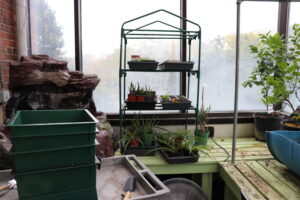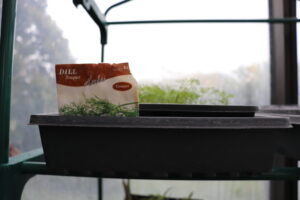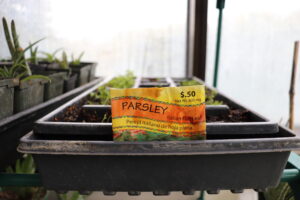Final report for YENC19-136
Project Information
The greenhouse at East High in Madison, WI sits empty, holding only potential when it should be full of students and flora. REAP Food Group will partner with the school to assist with basic improvement, supplies, and technical assistance. We envision the greenhouse as a place where students – especially those with disabilities – can learn about growing food in a climate-controlled environment with the help of farmers. Additionally, students will develop life skills, learn how food plays a role in economic development, and engage the broader school community through greenhouse and sustainable agriculture activities.
Garden-based learning will offer an opportunity for special education students to gain valuable skills, including educational support and vocational training. It is also an evidence-based method of helping youth with sensory challenges incorporate fresh fruits and vegetables into their diets.
This project includes three key objectives:
- Establish full functionality of the East High School greenhouse for all students, especially those with disabilities and autism.
- Use the indoor garden to demonstrate the benefits of seasonally sustainable agricultural projects.
- Implement plan to integrate greenhouse plants into multiple entry points within the school, including through consumption and sale by students.
Cooperators
- (Educator)
Educational & Outreach Activities
Participation Summary:
Consultations (4) - The East Occupational Therapy/Physical Therapy (OT/PT) Special Education team and Haley have met on three occasions for planning and development meetings regarding greenhouse projects. These have also included a local master gardener and REAP AmeriCorps members.
In addition, REAP / East personnel met with the Madison Metropolitan School District facilities manager and East HS facilities manager to discuss longterm improvements to the space, including installing a ventilation and fan system donated by University of Madison Horticulture department. We now have an estimate of cost ($20,000) and understanding of the required bidding process to pursue construction. We are in contact with East "adopt a school" partners who have funds to allocate toward school improvement projects to discuss donation possibilities, as well as looking into grant funding to make this next step in sustaining the greenhouse and improving production capability.
Update: A recent referendum passed to update East High School's facilities, and part of the plan includes ceasing use of the second greenhouse space in the building due to roof leakage and structural issues (upstairs from the one we are renovating, and most widely used by upper level science classes). This makes the conservation of the greenhouse space we are working in more valuable and pressing; 3 Madison middle schools have greenhouse or hoophouse spaces, but East is the only high school with a greenhouse space. We hope to leverage the progress we've made and opportunities available to update the space for better production management, including installing a large fan for improved circulation and temperature control, and a water filtration system to eliminate hard water scale build up on windows, which reduces direct sunlight availability in the space.
Additional consultations include connecting with other city urban agriculture resource groups Rooted and Seed to Table Program to explore cross connections in the school and city community as a way to make our programs more sustainable in both educational opportunities and resources, as well as funding opportunities through partnerships. Connecting this improved greenhouse space with the Seed to Table Program, a existing learning experience for East Students that teaches urban agriculture and gardening, food service skills, and entrepreneurship. Seed to Table happens offsite at a local community center, but having this greenhouse space available would provide students of that program another experience related to urban agriculture and sustainable food production. We look forward to exploring opportunities moving forward.
Curricula / Factsheets /Ed Tools (2) -
GrowLab, a curriculum published by the National Gardening Association, provides great ideas for integrating worksheets into student activities.
- A worm care guide was created by a REAP AmeriCorps team member alongside youth educator Haley Traun. Though we haven't yet figured out a composting system that respects the school's wishes and works well for students to access, bringing the REAP worm bins is a great way to engage students in discussions about composting and nutrient cycles
Links:
Youth engagement has grown steadily, with great room for growth in more heavily integrating entry points of the greenhouse into school activities, as well as involving greater numbers of students. Student use includes those enrolled in OT/PT and special education, which includes more individualized and group work depending on a students' needs - these students access the greenhouse the most. Students enrolled in culinary arts and environmental science have also made connections through coursework such as using produce and testing the greenhouse water supply for metals.
Press / Articles / Newsletters (4) -
The grant proposal details the following outreach goals: Italicized have been completed.
Article - featured on REAP website
- shared to 5 (goal of 10 across grant period) local news outlets (Isthmus, Capital Times, NBC15, Channel 3000, Wisconsin State Journal)
The sharing of this article did not produce content from the sources listed, but we are looking forward to sharing an end-of-year progress report with above sources as well as Madison Magazine, Badger Herald, Daily Cardinal, MATC Clarion, and La Comunidad (in Spanish) .
Article - shared by MMSD Facebook (9,063 followers)
- shared by local organization healthTIDE facebook (2,440 followers)
Progress update and final results in East High School bi-monthly parent and school community newsletter - Completed, distributed to 1,600 student body households, and 200+ staff members
Progress update and final results in quarterly REAP Reporter newsletter - Completed, distributed to nearly 4,000 members
https://files.constantcontact.com/eed7b44a001/73ff3a14-0617-471f-b711-01d3ba48280d.pdf - link to progress update
*For Spring 2021 as the district phases back in-person student learning, we will press release a progress update and plans for future to above mentioned news outlets. We are looking forward to news outlets embracing this positive story after a year of challenging community news.
Learning Outcomes
Understanding of basic agricultural concepts such as plant cycles, pollination, watering, natural pest management, and harvest
Understanding the concept of sustainable agriculture, specifically in supporting a profitable seedling program, creating a program that's good for the entire school community by connecting different student bodies, and an environmentally friendly agriculture program at East through minimal water and soil usage, composting, and using organic practices.
Application of newfound skills to vocational setting, such as in commercial greenhouse or retail. Especially beneficial in developing skills beyond cleaning or repetitive tasks, which individuals with disabilities are often pigeonholed into through work programs in many jobs, including in the greenhouse or agricultural sector.
Year 1 of this project was largely focused on experimenting with what is possible in the greenhouse space, generating more staff, student, and community support, and determining possible challenges that we need to be aware of when carrying out this project.
Results include staff records of daily progress with production, records of consultations / meetings, anecdotal evidence / quotes from students and staff, and the recorded educational and community outreach detailed in previous sections of the report.
Year 2 results from surveying students allowed us to understand the scope of success in activities related to changing knowledge, attitude skills and awareness of above sustainable agriculture concepts. From their newfound understanding of urban agriculture concepts and ways to grow plants for their school and family communities, students were able to plan for future projects during the pandemic, which greatly reduced their ability to access the greenhouse space on a regular basis and limited the ability to learn from the larger agricultural community through farmer visits.
A plan for the future that they are excited about is growing lettuce / greens, herbs, and tomatoes for harvest for the culinary arts program at East, and seedlings for sale to the larger community. Year one, students learned the necessary skills needed to grow these items, and also learned that they were the most successful with the space and resources provided. These items are appealing to both the culinary arts program as well as folks looking to grow their own plants at home & community gardens or in small indoor operations.
Through lesson activities, daily tasks in caring for greenhouse plants and produce, and connections between the tasks and responsibilities to other touch points of the student body, at least 10 students reported changes in knowledge, attitude, and skills. Also noted through our activities and surveying is qualitative evidence beyond the 10 students able to report changes in a traditional survey setting. We learned from this project that in order for diverse communities to sustainable agriculture, both quantitative and qualitative evidence supporting findings and next steps are necessary. We hope to continue learning from our results to be able to support this space as well as communicate through partnerships and publications the benefits of our findings to supporting sustainable agriculture in school and special education communities.
Project Outcomes
Through support with SARE funds, we have seen significant increased organizational support. This includes greater interest and participation from East High School staff, students, and supporters, as well as an additional small grant ($1,000) from Rotary Foundation of Madison to contribute to materials and staff time for the East greenhouse and another school garden program in the city. This momentum has been crucial for supporting East in their interest of this amazing school resource.
The success of this project has increased REAP's capacity to explore possibilities and methods for teaching urban agriculture to Madison students. Supporting this project demonstrates to REAP staff, supporters, and the larger school community that teaching youth about sustainable agriculture is possible despite school capacity and resources often being a challenge. The continuity of this project through seasons is also beneficial, as many school garden projects in the city struggle to maintain spaces for student use during the school year and organize labor during summer months. We look forward to exploring developments in farm-to-school programming that this project could inspire for the district. For example, food services doesn't currently accept student-grown produce in school meals. School garden sourcing could elevate agricultural connections for students and parents, which is an important aspect of sustainable food systems and food justice. Student, staff, and community support on positive school environment development can be a great catalyst to fostering change within the district. REAP will continue learning from the youth education and systematic components of this grant to color our work moving foward. We are confident that by the end of our grant period, East will continue to draw the support needed to advance and sustain this project.
- A student from East, who's main classroom space in the school is connected to the greenhouse, looks forward to seeding, transplanting, and watering the plants most days He is integral in keeping the space clean, organized, and well looked after. Then student also enjoys taking plants home to share and care for. Student ownership of this space bolsters a positive environment as well as affirms the potential of this resource to improve student experiences.
- The sale of tomato seedlings and houseplants to East staff and their friends and families has been a great success. The students have raised over $400 to put toward sustaining the greenhouse through their hard work of raising and selling their plants. Now that they have seen the success of this piece of the greenhouse, they have committed to doing regular sales to coincide with yearly school schedules and events, including houseplant sales around the holidays to provide people with a clutterless and meaningful gift to give, geraniums for mother's day, and vegetable seedlings at the end of the school year for planting in gardens during the summer. This also provides students involved with the greenhouse visibility throughout the school environment, which is important to students and staff. Plant sales provide purpose and goals related to the greenhouse production. Involving students, staff, families, and friends with the project shows a level of commitment and pride, as well as demonstrates a process of production and sale that can benefit student personal and vocational futures.
- Another successful outcome of this program has been the ability to integrate the culinary arts department with the production of food in the greenhouse. In fall 2019, there was enough basil and tomatoes to supply five class periods for an Italian recipe lab. This demonstrates to culinary students the benefits of sustainable, local sourcing, as well as creates visibility and real-world connections between the two student groups. As we improve the ability to produce vegetables and herbs in the greenhouse, this entry point will get stronger.
- A strong working connection with a local master gardener strengthens the program. She visits the greenhouse on a regular basis, and is able to use her expertise to inform and support East students and staff through this process in which many challenges arise, such as climate and humidity control, integrated pest management for whiteflies and aphids, plant nutrient care, and what types of produce will work best in the space (for example, cucumber seedlings were really fun for the students to grow, but once they reached maturity in the summer, it wasn't successful for us to hand pollinate them and we weren't able to actually produce cucumbers for consumption) Creating strong community connections allows everyone involved to learn more and feel supported.
- For the students and staff in the occupational and special education program to be able to access and support the greenhouse during the pandemic, when many students weren't able to access the space, is a huge success story and example of resilience and hope that sustainable agriculture projects can provide.
- "The ability to see the students come in here and see the life transform from seeds to soil into the actual finished product, (the students) always seem to love it." - quote from MMSD Occupational Therapist
Photos
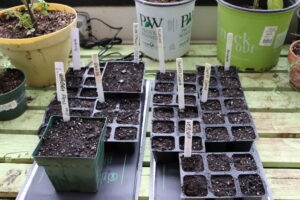
December 2019 - Various herb seedlings and leftovers from holiday plant sale on rack. Also shows green worm bin from REAP office making an appearance for students. The fountain behind it was donated by the parent of the staff member who used to have it in his office. The greenhouse functions as a space for relaxation and mindfulness for the students and staff.
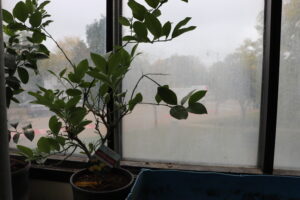
Students seeded herbs in winter 2019, and these were both transplanted to larger containers for use in classroom recipes or to take home.
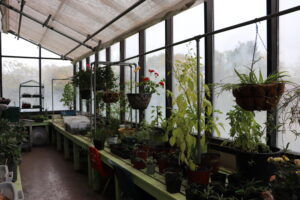
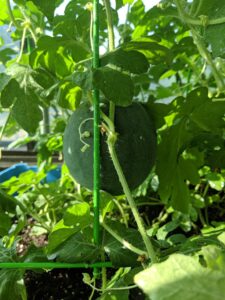
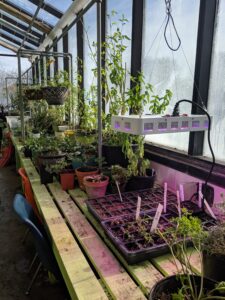
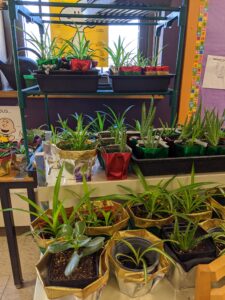
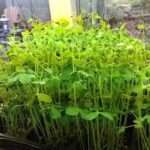
Thank you for the opportunity to work on this project. Though this year was difficult and we wish we could have had even more time with the students safely, we look forward to continuing this work!
